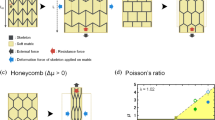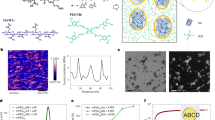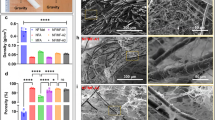Abstract
Hydrogels contain large amounts of water, making them useful in biomaterial applications. However, their inherent softness prevents their direct use in load-bearing applications. By incorporating toughening mechanisms through the double network concept, the mechanical properties of hydrogels have been greatly improved. In this Focus Review, our goal is to consider recent attempts to achieve hydrogel composites with further improved strength and toughness that could lead to the development of prosthetic biomaterials. We outline the way in which the double network concept improves the mechanical properties of gels and the specific mechanical traits that are enabled. We next review the current literature on soft composites, noting that the reinforcement mechanisms often differ from the double network concept, and summarize the types of properties that these materials can achieve. We also highlight the difficulties of working with hydrogels versus simple elastomers. Finally, we look at a recent subset of materials that utilize a mechanism analogous to the double network concept to achieve toughening on the macroscale. Macroscale double networks provide a unique opportunity to improve the mechanical properties of all soft materials for a wide range of applications.
This is a preview of subscription content, access via your institution
Access options
Subscribe to this journal
Receive 12 print issues and online access
$259.00 per year
only $21.58 per issue
Buy this article
- Purchase on Springer Link
- Instant access to full article PDF
Prices may be subject to local taxes which are calculated during checkout








Similar content being viewed by others
References
Ritchie RO. The conflicts between strength and toughness. Nat Mater. 2011;10:817–22.
Fratzl P, Weinkamer R. Nature’s hierarchical materials. Prog Mater Sci. 2007;52:1263–334.
Kannus P. Scand. J Med Sci Sport. 2000;10:312–20.
Rousseau M, Meibom A, Gèze M, Bourrat X, Angellier M, Lopez E. Dynamics of sheet nacre formation in bivalves. J Struct Biol. 2009;165:190–5.
Woo SL-Y, Abramowitch SD, C Loh, John, Musahl V, Wang JH-C. In Funct. Tissue Eng., 2003, pp. 17–34.
Race A, Amis AA. The mechanical properties of the two bundles of the human posterior cruciate ligament. J Biomech. 1994;27:13–24.
Barthelat F. Nacre from mollusk shells: a model for high-performance structural materials. Bioinspir Biomim. 2010;5:035001.
Almqvist N, Thomson NH, Smith BL, Stucky GD, Morse DE, Hansma PK. Methods for fabricating and characterizing a new generation of biomimetic materials. Mater Sci Eng C. 1999;7:37–43.
Rief M, Gautel M, Oesterhelt F, Fernandez JM, Gaub HE. Reversible unfolding of individual titin immunoglobulin domains by AFM. Science. 1997;276:1109–12.
Smith BL, Schäffer TE, Viani M, Thompson JB, Frederick NA, Kindt J, et al. Dietary antioxidants and age-related maculopathy: the Blue Mountains Eye Study. Nature. 1999;399:761–7.
Thompson JB, Kindt JH, Drake B, Hansma HG, Morse DE, Hansma PK. Bone indentation recovery time correlates with bond reforming time. Nature. 2001;414:773–6.
Fantner GE, Oroudjev E, Schitter G, Golde LS, Thurner P, Finch MM, et al. Sacrificial bonds and hidden length: unraveling molecular mesostructures in tough materials. Biophys J. 2006;90:1411–8.
Zhao X, Chen X, Yuk H, Lin S, Liu X, Parada G. Soft materials by design: unconventional polymer networks give extreme properties. Chem Rev. 2021;121:4309–72.
Tottoli EM, Dorati R, Genta I, Chiesa E, Pisani S, Conti B. Skin wound healing process and new emerging technologies for skin wound care and regeneration. Pharmaceutics. 2020;12:735.
Mascarenhas R, MacDonald PBP. Anterior cruciate ligament reconstruction: a look at prosthetics-past, present and possible future. McGill J Med MJM. 2008;11:29–37.
Corner EM. Notes of a case illustrative of an artificial anterior crucial ligament, demonstrating the action of that ligament. Proc R Soc Med. 1914;7:120–1.
Jenkins DHR. The repair of cruciate ligaments with flexible carbon fibre. A longer term study of the induction of new ligaments and of the fate of the implanted carbon. J Bone Jt Surg. 1978;60-B:520–2.
Scharling M. Replacement of the anterior cruciate ligament with a polyethylene prosthetic ligament. Acta Orthop. 1981;52:575–8.
Gong JP. Why are double network hydrogels so tough. Soft Matter. 2010;6:2583.
Creton C. 50th anniversary perspective: networks and gels: soft but dynamic and tough. Macromolecules. 2017;50:8297–316.
Gong JP, Katsuyama Y, Kurokawa T, Osada Y. Double-network hydrogels with extremely high mechanical strength. Adv Mater. 2003;15:1155–8.
Okumura Y, Ito K. The polyrotaxane gel: a topological gel by figure-of-eight cross-links. Adv Mater. 2001;13:485–7.
Noda Y, Hayashi Y, Ito K. From topological gels to slide‐ring materials. J Appl Polym Sci. 2014;131:1.
Liu C, Kadono H, Mayumi K, Kato K, Yokoyama H, Ito K. Unusual fracture behavior of slide-ring gels with movable cross-links. ACS Macro Lett. 2017;6:1409–13.
Haraguchi K, Takeshisa T. Nanocomposite hydrogels: a unique organic–inorganic network structure with extraordinary mechanical, optical, and swelling/de-swelling properties. Adv Mater. 2002;14:1120.
Sun J-Y, Zhao X, Illeperuma WRK, Chaudhuri O, Oh KH, Mooney DJ, et al. Highly stretchable and tough hydrogels. Nature. 2012;489:133–6.
Sun TL, Kurokawa T, Kuroda S, Bin Ihsan A, Akasaki T, Sato K, et al. Physical hydrogels composed of polyampholytes demonstrate high toughness and viscoelasticity. Nat Mater. 2013;12:932–7.
Zhang HJ, Sun TL, Zhang AK, Ikura Y, Nakajima T, Nonoyama T, et al. Tough Physical Double-Network Hydrogels Based on Amphiphilic Triblock Copolymers. Adv Mater 2016;28:4884–90.
Haque MA, Kurokawa T, Gong JP. Super tough double network hydrogels and their application as biomaterials. Polymer. 2012;53:1805–22.
Nonoyama T, Gong JP. Tough double network hydrogel and its biomedical applications. Annu Rev Chem Biomol Eng. 2021;12:393–410.
Nakajima T, Sato H, Zhao Y, Kawahara S, Kurokawa T, Sugahara K, et al. A universal molecular stent method to toughen any hydrogels based on double network concept. Adv Funct Mater. 2012;22:4426–32.
Nakajima T, Ozaki Y, Namba R, Ota K, Maida Y, Matsuda T, et al. Tough double-network gels and elastomers from the nonprestretched first network. ACS Macro Lett. 2019;8:1407–12.
Matsuda T, Nakajima T, Fukuda Y, Hong W, Sakai T, Kurokawa T, et al. Yielding criteria of double network hydrogels. Macromolecules. 2016;49:1865–72.
Nakajima T, Kurokawa T, Ahmed S, Wu WL, Gong JP. Characterization of internal fracture process of double network hydrogels under uniaxial elongation. Soft Matter. 2013;9:1955–66.
Khang D-YY, Jiang H, Huang Y, Rogers JA. A stretchable form of single-crystal silicon for high-performance electronics on rubber substrates. Science. 2006;311:208–12.
Kim D-H, Ghaffari R, Lu N, Rogers JA. Flexible and stretchable electronics for biointegrated devices. Annu Rev Biomed Eng. 2012;14:113–28.
Bharambe V, Parekh DP, Ladd C, Moussa K, Dickey MD, Adams JJ. Addit Manuf. 2017;18:221–7.
Bartlett MD, Fassler A, Kazem N, Markvicka EJ, Mandal P, Majidi C. Stretchable, high-k dielectric elastomers through liquid-metal inclusions. Adv Mater. 2016;28:3726–31.
Dickey MD. Stretchable and soft electronics using liquid metals. Adv Mater. 2017;29:1606425.
Style RW, Boltyanskiy R, Allen B, Jensen KE, Foote HP, Wettlaufer JS, et al. Stiffening solids with liquid inclusions. Nat Phys. 2015;11:82–87.
Kazem N, Bartlett MD, Majidi C. Extreme toughening of soft materials with liquid metal. Adv Mater. 2018;30:1706594.
Buckner TL, Yuen MC, Kim SY, Kramer‐Bottiglio R. Enhanced variable stiffness and variable stretchability enabled by phase‐changing particulate additives. Adv Funct Mater. 2019;29:1903368.
Shan W, Lu T, Majidi C. Soft-matter composites with electrically tunable elastic rigidity. Smart Mater Struct 2013;22:085005.
Schubert BE, Floreano D. Variable stiffness material based on rigid low-melting-point-alloy microstructures embedded in soft poly(dimethylsiloxane) (PDMS). RSC Adv. 2013;3:24671.
Tonazzini A, Mintchev S, Schubert B, Mazzolai B, Shintake J, Floreano D. Variable stiffness fiber with self-healing capability. Adv Mater. 2016;28:10142–8.
Kazem N, Hellebrekers T, Majidi C. Soft multifunctional composites and emulsions with liquid metals. Adv Mater. 2017;29:1605985.
Agrawal A, Rahbar N, Calvert PD. Strong fiber-reinforced hydrogel. Acta Biomater. 2013;9:5313–8.
Lin S, Cao C, Wang Q, Gonzalez M, Dolbow JE, Zhao X. Design of stiff, tough and stretchy hydrogel composites via nanoscale hybrid crosslinking and macroscale fiber reinforcement. Soft Matter. 2014;10:7519–27.
Illeperuma WRKK, Sun J, Suo Z, Vlassak JJ. Fiber-reinforced tough hydrogels. Extrem Mech Lett. 2014;1:90–6.
Feng X, Ma Z, MacArthur JV, Giuffre CJ, Bastawros AF, Hong W. A highly stretchable double-network composite. Soft Matter. 2016;12:8999–9006.
King DR, Okumura T, Takahashi R, Kurokawa T, Gong JP. Macroscale double networks: design criteria for optimizing strength and toughness. ACS Appl Mater Interfaces. 2019;11:35343–53.
Cooper CB, Joshipura ID, Parekh DP, Norkett J, Mailen R, Miller VM, et al. Toughening stretchable fibers via serial fracturing of a metallic core. Sci Adv. 2019;5:4600. eaat4600
Tao Z, Fan H, Huang J, Sun T, Kurokawa T, Gong JP. Fabrication of tough hydrogel composites from photoresponsive polymers to show double-network effect. ACS Appl Mater Interfaces. 2019;11:37139–46.
Zhu F, Cheng L, Wang ZJ, Hong W, Wu ZL, Yin J, et al. 3D-printed ultratough hydrogel structures with titin-like domains. ACS Appl Mater Interfaces. 2017;9:11363–7.
Zou S, Therriault D, Gosselin FP. Spiderweb-inspired, transparent, impact-absorbing composite. Cell Rep. Phys Sci. 2020;1:100240.
Zou S, Therriault D, Gosselin FP. Toughening elastomers via microstructured thermoplastic fibers with sacrificial bonds and hidden lengths. Extrem Mech Lett. 2021;43:101208.
Okumura T, Takahashi R, Hagita K, King DR, Gong JP. Improving the strength and toughness of macroscale double networks by exploiting Poisson’s ratio mismatch. Sci Rep. 2021;11:13280.
Tauber J, Dussi S, van der Gucht J. Microscopic insights into the failure of elastic double networks. Phys Rev Mater. 2020;4:063603.
Tauber J, Rovigatti L, Dussi S, van der Gucht J. Sharing the load: stress redistribution governs fracture of polymer double networks. Macromolecules. 2021;54:8563–74.
Takahashi R, Sun TL, Saruwatari Y, Kurokawa T, King DR, Gong JP. Creating stiff, tough, and functional hydrogel composites with low-melting-point alloys. Adv Mater. 2018;30:1706885.
Hua M, Wu S, Ma Y, Zhao Y, Chen Z, Frenkel I, et al. Strong tough hydrogels via the synergy of freeze-casting and salting out. Nature. 2021;590:594–9.
Park N, Kim J. Anisotropic hydrogels with a multiscale hierarchical structure exhibiting high strength and toughness for mimicking tendons. ACS Appl Mater Interfaces. 2022;14:4479–89.
Feng X, Ma Z, MacArthur JV, Hong W. Magnetic double-network composite capable of large recoverable deformation. Soft Matter. 2021;17:554–62.
Liang X, Fu H, Crosby AJ. Phase-transforming metamaterial with magnetic interactions. Proc Natl Acad Sci. 2022;119:e2118161119.
Acknowledgements
DRK would like to acknowledge financial support from Grant-in-Aid for Scientific Research Nos. 17H06144 and 20K20193 from the Japan Society for the Promotion of Science (JSPS).
Author information
Authors and Affiliations
Corresponding author
Ethics declarations
Conflict of interest
The authors declare no competing interests.
Additional information
Publisher’s note Springer Nature remains neutral with regard to jurisdictional claims in published maps and institutional affiliations.
Rights and permissions
About this article
Cite this article
King, D.R. Macroscale double networks: highly dissipative soft composites. Polym J 54, 943–955 (2022). https://doi.org/10.1038/s41428-022-00646-8
Received:
Revised:
Accepted:
Published:
Issue Date:
DOI: https://doi.org/10.1038/s41428-022-00646-8



